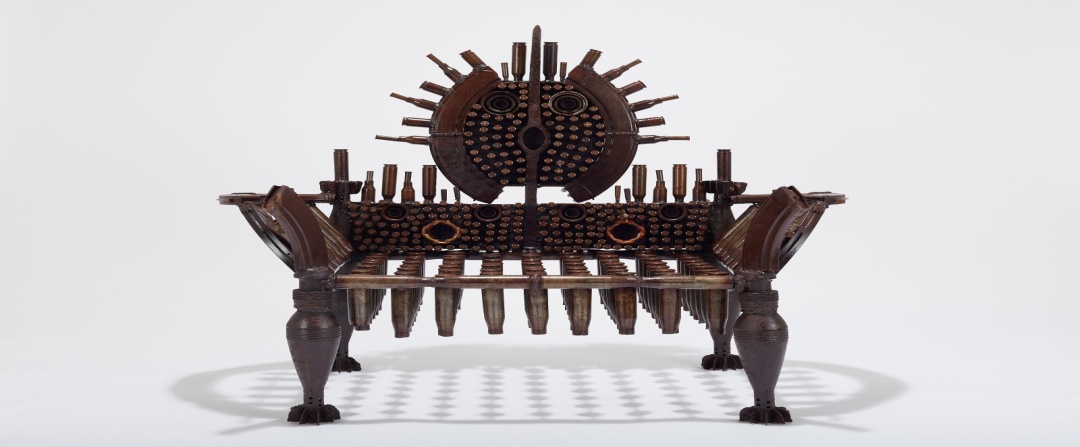Goncalo Mabunda
Goncalo Mabunda was born on January 1st 1975 in Maputo. For a long time, the artist has continued living with his uncle, a Frelimo fighter in Maputo. At age seven, the young man felt the gun weight from his uncle, an incident that transpired him to change the nation. He was determined to transform a country destroyed by a terrible civil war. Mabunda started as a gallery manager at Maputo Nuclear de Arte. Later in 1995, he was inspired by the Union of Christian Churches, which wanted to encourage gun owners to return their rifles in exchange for agriculture and building. Through his active participation, he became interested in artistic activities. Presently, Mabunda is well recognized across the globe for his thrones. In his opinion, these thrones represent the attributes of power, culture, and the tribal symbol of ethnic African art. They are undoubtedly an irony of dealing with the childhood experience of absurdity and civil war that attacked Mozambique for a relatively long time. Therefore, Mabunda tries to prove that while war may be used to attain power, art may be used as a significant tool to restore sanity in a nation. These two contradicting perspectives borrow critical lessons from one another and hence will be discussed in the paper.
Piece of Artwork: The Chronicler’s Throne, 2021

The chronicle’s throne is regarded as one of the noble yet classic forms of Mabunda’s work. In the piece of art, he provides anthropomorphic forms of AK47s, pistols, rocket launchers, and other weapons of destruction. Mabunda’s unsettling, totemic sculpture explores the bloody political history of Mozambique, particularly the civil war that had gripped the nation over the past fifteen years (Ferreira et al. 17). He takes the opportunity to use these destructive weapons to create stunning furniture and mask. His perfect blend takes a striking edge to the imagery of the African artistic chair used by kings. The beautiful object reflects art’s transformative power and creativity’s resilience in modern African societies.
Object’s Function and Purpose
While making it, the renowned artists wanted to create a memory of the war that had engulfed Mozambique. He wanted to show the world the different forms of destructive weapons that had been used to propel the war. He aimed to show the audience how the people of Mozambique had suffered over the past years. Subsequently, he wanted to communicate how violence can be terminated and destroyed weapons used aesthetically. Finally, he intended to use irony to provide alternative uses for rocket launchers, bombs, and rifles rather than to kill. He aimed to explain to the global community the need to use his past bad experiences to create some of the most exciting pieces of art for future reference.
Presently, his work has acted as a modernist way of challenging the absurdity of the civil war that had affected Mozambique over the past years. In the Chronicle Throne pieces of art, Mabunda mocks how the traditional power of the throne rested on weapons (Nortey et al. 52). The new artistic technique clearly remembers how the political leaders propelled the African guerrilla war in the power struggle. His quotidian inclusions have further provided the audience across the globe with a way to reconcile the actions of people, corporations, and governments against selling and supplying dangerous arms. In other words, the piece of art has acted as an important warning to the present government, which may be interested in using the armed-violence to reinforce its power. Therefore, it is a perfect lesson to the present global leaders on the need to refrain from wars.
According to Mabunda, the Chronicle Throne acted as a political attribute of power and a cultural symbol of ethnic African art. In other words, the piece became a symbol of African cultural heritage (Khan et al. 113). While using the deactivated weapons to design the seat, Mabunda pulled the African attire’s realism to show the black culture’s beautiful nature. His work was a representation of how African leaders took the opportunity to lead the throne by the use of guns. Therefore, he warns other leaders against following the same path used by their hostile counterparts.
Visual Analysis and Personal Observation Questions
It is observed that Mabunda’s works have perfectly fused the past with the present moment, tragedy with transformation, and tradition with innovation to show the globe how objects of destruction can be used to inspire and create hope in society. He has used the sad incident of the Mozambique republic to warn the globe against the dangers of war while simultaneously bringing hope to the new world. Nevertheless, I still have many questions regarding his art. First, what will is the global view of Mozambique based on the artworks? Second, if all the objects in the artwork were used during the civil war, how many people died during the period? Even though we may not have the ultimate answers to these questions, the audience must take a keen interest in the issues raised.
Works Cited
Ferreira, Ângela, and Mónica de Miranda. Atlantica: Contemporary Art from Mozambique and Its Diaspora. No. 1. Hangar Books, 2020: 1-179. Web.
Khan, Sheila Pereira, Maria Paula Meneses, and Bjørn Enge Bertelsen. Mozambique on the Move: Challenges and Reflections. Brill, 2018: 1-279. Web.
Nortey, Samuel, Edwin K. Bodjawah, and Kwaku Boafo Kissiedu. “African Masking Systems: An Archive of Social Commentary.” African Arts 54.4 (2021): 52-63. Web.